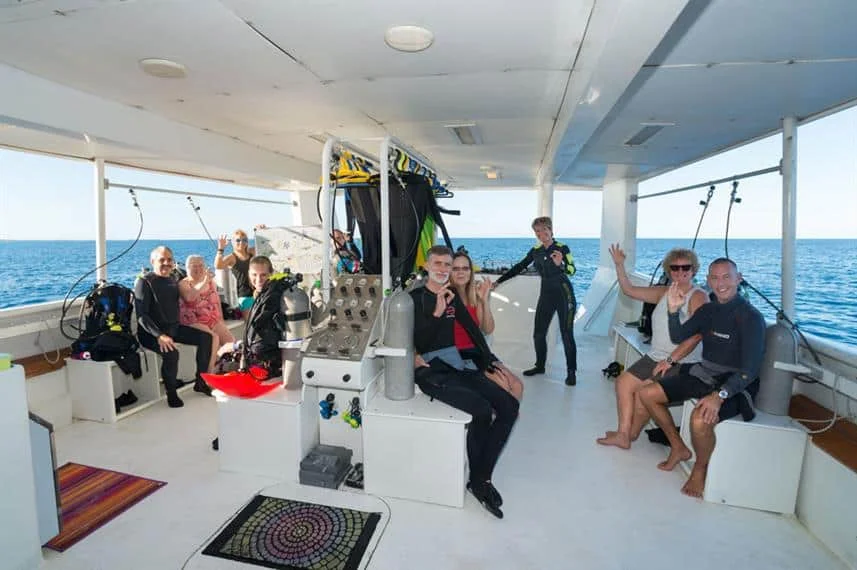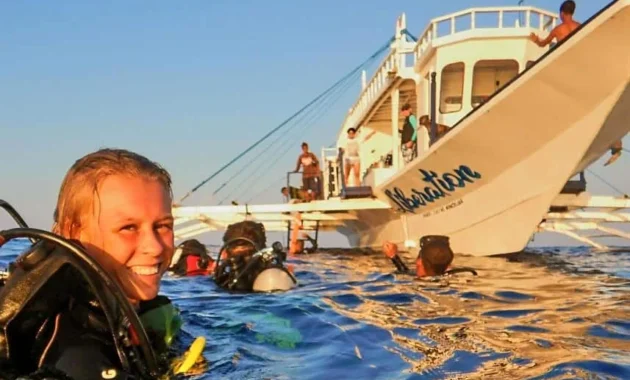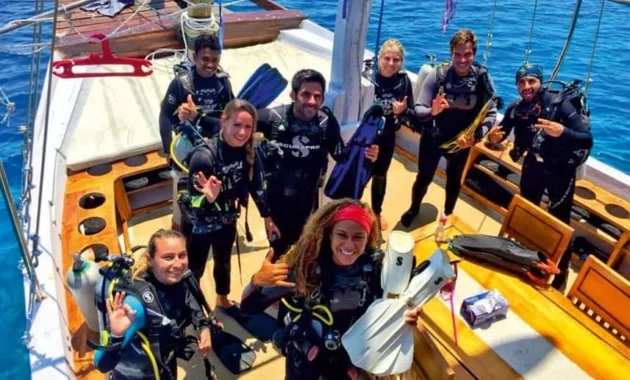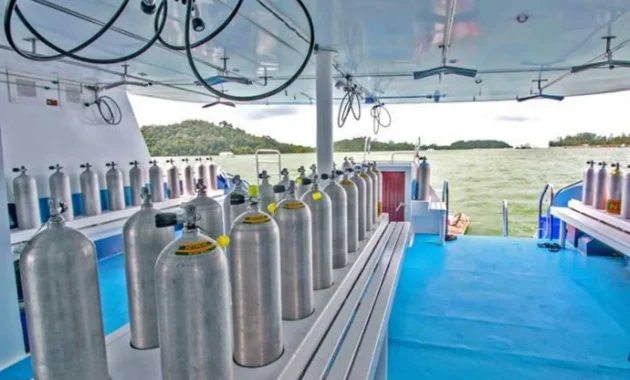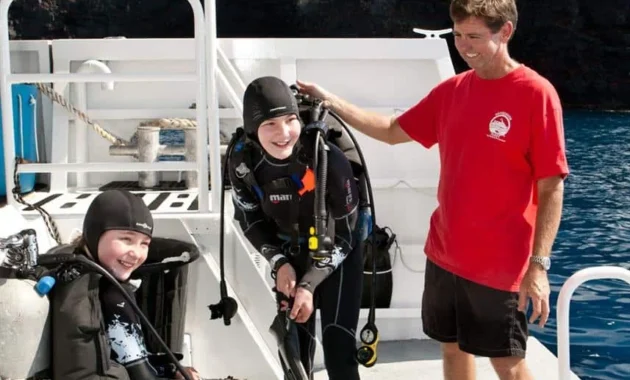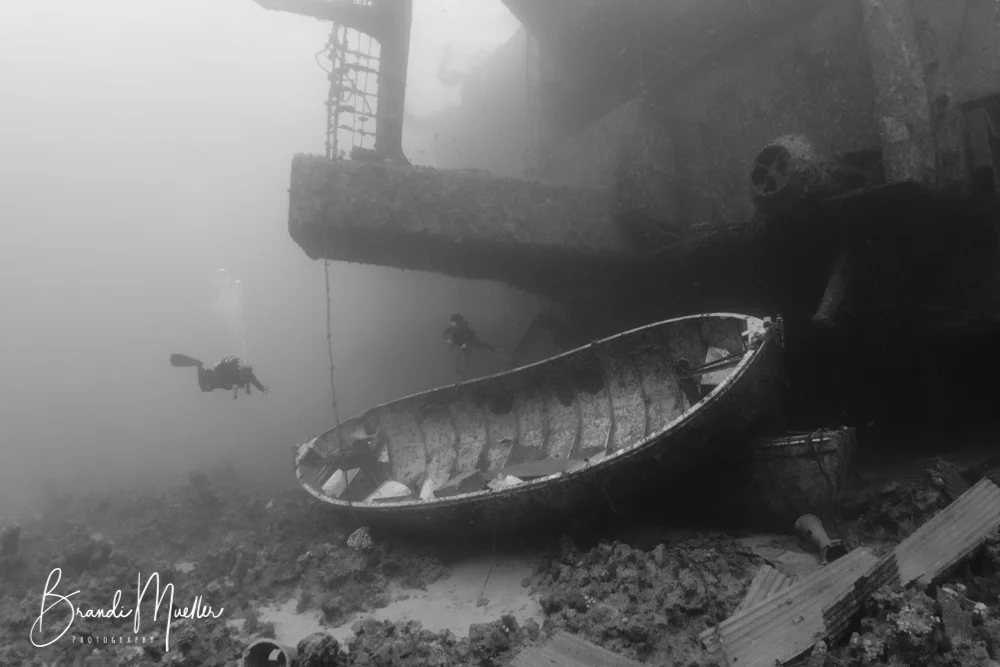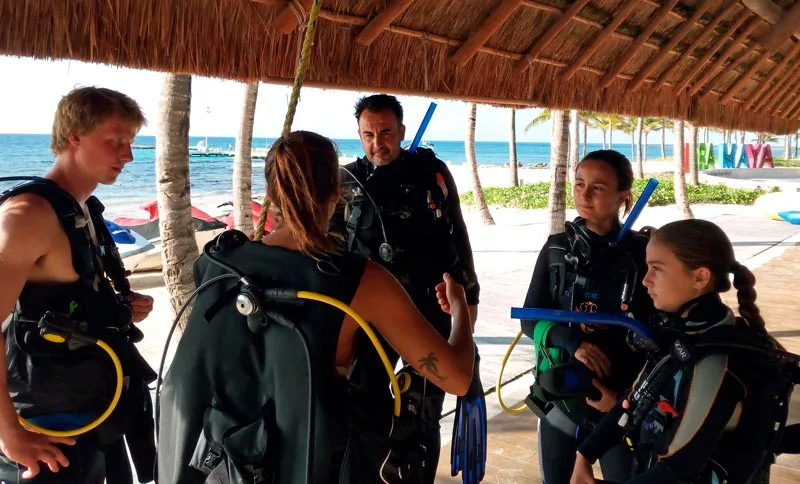In simple terms, liveaboard diving is a multi-day boat trip where scuba divers get to eat, sleep, relax, and dive. Liveaboard dive boats are specially designed or adapted to accommodate divers and all their equipment and feature a diving platform or deck where divers can kit up.
The length of a liveaboard can be anywhere from three days to two weeks, with an average duration of seven days. Group sizes vary depending on the size of the vessel but will typically be 10 to 30 people.
Liveaboard boats have cabins for accommodation, a restaurant, lounge or bar area, sun decks, and areas for storing and washing diving equipment. Many also have photo-stations where photographers can download and play slideshows or videos taken during dives.
- Who Can Join a Liveaboard Dive Trip?
- Do I Need to Have a Buddy to go on a Liveaboard?
- Why is Liveaboard Diving Special?
- Things to Consider Before Choosing a Liveaboard Diving Trip
- Liveaboard Diving and Nitrox
- Liveaboard Checklist: What You Should Bring
- Why You Need a Dive Computer
- What Not to Bring on a Liveaboard
- Handy Liveaboard Hacks
- Liveaboard Terminology
Who Can Join a Liveaboard Dive Trip?
A common liveaboard misconception is that the diving is difficult and only meant for expert divers, but this couldn’t be further from the truth. You obviously need to know what you’re doing but most liveaboards accept Open Water divers.
Having an Advanced Open Water qualification is often beneficial as it allows you to explore dive sites more fully, but it’s usually not a necessity. Some liveaboards will even allow you to gain your Advanced certification while onboard.
If like many recreational divers you haven’t been in the water for a year or more, refresher dives can be arranged to bring you back up to speed. That said, if you can get in the water before you get aboard and quickly refresh your basic skills and buoyancy, that’s better than do so on the boat.
Do I Need to Have a Buddy to go on a Liveaboard?
Many divers wrongly assume that they can’t go on a liveaboard trip unless they travel with a buddy. But you’ll find plenty of divers on board who also need a buddy. The liveaboard staff will match you up with a dive buddy who has a similar experience level.
Why is Liveaboard Diving Special?
Many experienced divers consider liveaboards and dive safaris as the only way to truly enjoy a diving vacation, especially if heading to remote destinations such as the Similan Islands in Thailand or Osprey Reef in Australia’s Coral Sea.
So what makes liveaboard diving so special and different from daily dive trips?
More Diving
When diving with a land-based dive operator or resort, you’re usually restricted to two or three dives a day at local sites. A liveaboard is all about the diving and you will have the option of doing three, four, or even five dives a day.
Unique Diving
A liveaboard allows travel to far greater distances from shore, visiting more remote and unique dive sites than local dive boats can access. With fewer divers frequenting these sites, the reefs are untouched and more pristine. Being out in the blue means that you will often encounter marine life not seen close to shore, including large pelagic species.
Convenience
There is no diving more convenient than liveaboard diving. You’ll usually be assigned a slot or station on the boat where you set up your gear and it remains for the duration of your trip. Kit up once when you arrive and that’s it! No need to disassemble your equipment until the adventure is over.
You won’t need to haul tanks about either as most liveaboards feature a whip compressor system whereby tanks are refilled in place.
An Experience Outside the Ordinary
What could be better than waking up in the morning, sitting out on the deck with a coffee and being surrounded by blue water stretching for miles? There’s something mesmerizing about watching the sun come up over the water and spending evenings on the ocean. Star gazers are always impressed by the nightly vistas thanks to the lack of light pollution.
When not diving, you often have the opportunity to step ashore on far-flung islands and atolls, or even spend time snorkeling in the shallows. Some liveaboard destinations offer the best snorkeling you will ever encounter.
Meet New People
Liveaboards bring together a group of individuals united in one common interest: diving. Downtimes, meals, and evenings of relaxation provide plenty of opportunities to get to know a group of fellow enthusiasts from different backgrounds and with a range of experiences. Living in such close quarters makes it easy to make new friends.
Things to Consider Before Choosing a Liveaboard Diving Trip
The list of liveaboard diving options is endless so it can be tough knowing where to start finding a trip that suits your needs. By taking certain things into consideration, you can narrow down the options and make the decision much easier.
Budget
Scuba diving is becoming more affordable but it’s still an expensive hobby so considering your budget is a great place to start. Liveaboards come in all price ranges from budget-friendly to mid-range to expensive top-end options.
At the lower end of the scale, operators will offer shared cabins and communal bathrooms. The more luxurious liveaboards feel like boutique hotels and offer en-suite cabins with a fridge and TV. Some even feature hot tubs, massage services, and all-inclusive bars.
One way to keep the price down is to head to your chosen destination outside of the peak season. Many operators offer reduced prices to fill up off-season excursions. Even off-peak the diving will still be great. Whatever your budget, there is a liveaboard to suit your lifestyle.
Destination
Liveaboards operate all over the world so selecting the right destination will take some consideration. Ask yourself a few key questions:
- Can you tolerate cold water or do you prefer the tropics and warmer waters?
- What type of marine life do you want to see and is it seasonal?
- How long will the journey take from your home to the departure point?
- Which destinations can you afford?
Type Of Diving
Think about the type of diving on offer in the region. Do you enjoy relaxing diving or are fast-paced drift dives more your thing? How about muck diving or wrecks? Perhaps you would be happier with a mix of different dive types; a bit of reef, some wrecks, and a balance between harder and easier dives.
A wealth of information on popular dive sites is available on the internet to help you make a decision. Check the itinerary of the trip you’re considering and then research the dive sites. It can be great fun looking into all the exotic destinations so if you’re struggling to make a final decision, you could always arrange another liveaboard to a different place for the following year!
Liveaboard Itineraries
Most liveaboards include as much diving as possible but it’s always good to check the itinerary before booking. A few points to research are:
- Duration of the safari
- Number of dives and how many days will you spend diving
- Travel times from departure point to dive sites
- Any long open-water crossings that mean no diving for an afternoon
- Are excursions included?
- Are early morning and night dives included or is there an additional charge?
Everyone has their own idea of the most important factor when choosing a liveaboard. Just remember to do your research and check reviews of both boats and operators.
Sustainability
As consumers, we’re in a unique position to vote with our wallets, meaning we can choose to support companies that have shown dedication to sustainable practices. Find out if the provider you’re considering has a single-use plastics policy and read reviews from past divers to get a feel for their green credentials.
Choosing a Liveaboard Company
Once you’ve settled on a destination and the type of itinerary you’re after, you need to choose an operator. Online reviews are the perfect place to start. Make sure the trip you’ve chosen has plenty of excellent reviews and no mentions of poor or lacking safety procedures.
Finding a liveaboard dive trip with 100 percent perfect reviews is rare, bear in mind you need to read reviews critically. That one negative review left by a guest because he or she didn’t like the way staff seasoned the salad is less important than a negative review that brings up important safety matters.
Liveaboard Diving and Nitrox
If you haven’t taken your Nitrox certification yet, we urge you to consider it before your trip. Nitrox or EANx is enriched air. Instead of the standard 21% oxygen and 79% nitrogen in your tanks, you can have a higher percentage of oxygen.
The primary benefit of Nitrox is that it exposes you to less nitrogen, something that’s important when you’re completing up to five dives per day.
A knock-on effect of diving Nitrox for the duration of your trip is that your allowable bottom times will be longer. If you dive air for the entire liveaboard, you’ll quickly notice that by day three or even two, your no-decompression limits are substantially shortened.
This is because your body has on-gassed a certain amount of nitrogen and your computer is setting limits based on the theoretical nitrogen levels in your body — we say theoretical because your computer doesn’t know exactly how much nitrogen is in your body, it can only estimate based on the dives you have done.
Removing some of this nitrogen and replacing it with oxygen is a safer choice for liveaboard diving. Many divers report feeling less tired after diving with Nitrox and you might find the same to be true.
If you have no time to complete a Nitrox certification before you go, find out if the liveaboard offers Nitrox courses. Most liveaboards do and since your EANx ticket is a short dry course, it won’t take too much time.
Is There Free Nitrox on all Liveaboards?
Plenty of liveaboards offer Nitrox completely free of charge while other operators offer Nitrox packages for a set price. If the liveaboard trip charges by the tank, this extra cost can quickly add up. Finding a liveaboard operator with free or affordable Nitrox packages is worth the extra effort.
Liveaboard Checklist: What You Should Bring
Many liveaboard operators provide their own checklist of what to pack for the trip. However, there would be nothing worse than climbing on board and realizing you’ve forgotten an important piece of kit.
If you have your own dive gear, obviously don’t forget your BCD, regs, mask, fins, and booties. Here are a few other essentials that need to be on your packing list.
Exposure Suit
The dives can be long and on a liveaboard, you’ll do as many as four or five dives each day, so it’s important to be comfortable. Even if the waters are a balmy temperature, diving in just a skin suit or swimmers day after day can cause your core body temperature to drop. Find out about expected water temperatures from the operator and ask for their advice on suit thickness.
Underlayers
Having to cut a dive short because of the cold is not ideal. Pack the right exposure suit for the conditions you’ll be diving in and consider bringing a chicken vest, hood, or a thermal rash vest for additional layers when needed.
During early morning or night dives, the water temperature can be lower and the air temperature has dropped. Thermals and rash vests come in a variety of thicknesses and can keep you snug in colder conditions. Taking two or three underlayers means you’ll always have a dry one to put on for each dive.
SMB and Reel
When you’re diving from a liveaboard, you need your own surface marker buoy (SMB) and a reel. Most of the time, you will send your SMB up at the safety stop but some dives, particularly those in a current, might mean you have your SMB up for the whole dive. The dive staff on board your liveaboard will let you know the procedures for each dive in their briefings.
If you’ve never used an SMB before, it’s a good idea to get some practice in before you go on the trip.
Flashlight
Exploring reefs at night gives you the chance to see a whole new set of sea creatures. Most liveaboards offer daily night dives. It’s helpful to have your own torch so you avoid any rental fees. Don’t forget that each buddy team should have at least one spare torch between them so consider packing an extra.
Batteries
All too often divers on liveaboards forget this crucial item. You’ll need enough torches for your flashlight and your camera. Make sure you bring enough batteries for the entire trip. Bear in mind that a flashlight’s batteries should be changed after a maximum of three night dives, depending on the duration of the dive and the type of batteries you’re using.
DIN/International Adaptors
Double-check which kind of tanks the liveaboard uses and if they supply adaptors. If the boat only has DIN tanks and your regs are International, you’ll need an International adaptor. If the boat has International tanks, bring a few inserts with you.
Suitable Clothing
You’re going to have a lot of chill-out time between dives. If you’re heading somewhere hot, swimsuits, a sun hat, and sunglasses are essential. For colder destinations, it may be advisable to take a coat, scarf, gloves, and a warm hat. Whether you’re planning on sunning yourself on the deck or chilling in your cabin, make sure you have comfortable and appropriate clothing.
Many of the regions visited by liveaboards feature remote islands and rock formations which can be explored. If you’re given the opportunity to head onto land during some downtime, closed-toe shoes are a must for trekking over rocky terrain.
Toiletries
Many liveaboards provide shampoo and soap or shower gel. Spending so much time in the water can leave your skin and hair extremely dry. Be sure to pack moisturizer, lip balm, and a good leave-in conditioner. And don’t forget the reef-friendly sunscreen to protect yourself from UV rays and the coral from harmful chemicals.
Seasickness Medication
Even if you consider yourself a bit of a sea dog and think seasickness won’t affect you, we suggest packing some anti-seasickness medication just in case. Being at sea in rough waters can bring on random bouts of seasickness which is not fun, especially at night.
Consider taking non-drowsy pills for the daytime and drowsy to help you sleep at night so you wake up refreshed and ready for the day of diving ahead. Be proactive with seasickness medication as opposed to waiting until you feel green around the gills.
Ear Plugs and Eye Mask
Lots of diving means you need plenty of sleep to get the most out of a liveaboard. As the boat moves to new locations during the night, the sound of its engines can lead to disturbed sleep patterns. Earplugs can be a godsend for ensuring you get a good night’s rest. Eye masks are also a great idea for getting a bit of shut-eye between dives.
Camera Equipment
If you’re a budding underwater photographer, make sure you pack everything required to capture the perfect shots. Check, double-check, and triple-check you have all the chargers, filters, and lenses you need. Taking extra batteries helps ensure you’ll have a working camera after a short surface interval. Remember to pack plenty of memory cards or a hard drive to download and store your snaps.
Always unplug any electronics and cameras when you are finished charging them.
Dive Medical
Most liveaboard operators require a recent dive medical at the time of booking, if not you should ask yourself if the operator is truly dedicated to safety. After all, if you have any health issues that could impact your safety, your crew needs to know about it.
Head to your GP and ask for a dive medical before the trip. Bring the medical form provided by the liveaboard and make sure you answer it honestly.
Why You Need a Dive Computer
Many liveaboard operators mandate that each diver has their own dive computer and for good reason. Doing repetitive multi-level dives each day means it’s crucial that you have a computer to monitor and compute nitrogen loading and no-decompression limits for each dive. Your computer will keep you within the safe dive limits throughout your trip and minimize the risk of decompression sickness (DCS).
While it is possible to manage your dives with a table such as the recreational dive planner (RDP), these tables assume a square profile and don’t account for multilevel diving anywhere near as well as a computer does.
What Not to Bring on a Liveaboard
Although you don’t want to forget important items, the one thing you don’t want to do is overpack. Cabins have limited storage space so the lighter you can pack the better. Plus, reducing the amount you take could mean avoiding additional airline baggage fees.
Here are a few items that are less important on a liveaboard trip:
- Shoes: Most boats have a no-shoe policy so there’s no need to pack shoes for lots of different occasions.
- Clothes: You’ll be diving most of the time so what do you really need? And as you’ll be staying in for dinner, leave the going out clothes at home. You need some clothes, of course, but not half of your wardrobe!
- Electronics: The majority of liveaboards have plenty of entertainment options onboard so there’s no need to overdo it on the electronics. Do bring one device so you can chill out in your berth and watch a show.
- Brand spanking new equipment you’ve never used before: Try and bring kit you know and are familiar with. Be aware that boat staff and dive guides won’t be too pleased if you’re still taking tags off your new suit while all the other divers are in the water.
Handy Liveaboard Hacks
A bit of in-the-know knowledge can make a big difference to your liveaboard experience. We spoke to dive instructors who work on liveaboards and compiled these handy liveaboard hacks.
Heavy-duty Clothespin
Nothing is more annoying than your wet wetsuit continuously falling off the drying rail or the hanger in the wind. Or expecting your wetsuit to be dry and finding it on a soggy heap on the deck. A strong clothespin can secure your wetsuit in place and maximize drying time.
Rehydration Sachets
All that diving can take its toll on your hydration levels. Stay dive fit by keeping a few packs of single-serve rehydration salts in your cabin.
Name Your Gear
On a liveaboard, many divers have the exact same brand of equipment. Avoid mix-ups by labeling all your gear with a white marker.
Bring a Robe
As you’ll be diving a lot, it’s easy for your core body temperature to drop. For that reason, you should always take your wetsuit off between dives. Avoid feeling the chill with a fluffy robe to wrap up in for surface intervals.
Spring Straps
Struggling to get your fins on and off causes delays when divers are waiting to get back on the deck or the zodiac, plus it’s just plain annoying for you the diver. Hack your equipment donning and doffing with a set of spring straps for your fins.
Easy Photo Organization
This sweet hack for underwater photographers will organize your images will minimal effort. Take a photo of the dive map before each dive, you’ll have a digital dive log to reference and you’ll know which photos are from which site.
Multiple Swimsuits
If you have several swimsuits with you, you’re less likely to sit around in wet swimmers and get chilly. Change your swimwear after each dive and dry the wet pair. This is even easier if you’re wrapped up in the robe we suggested in our previous hack.
Leave-in Conditioner
There’s no doubt about it, diving three or four times a day will destroy your long hair. Guys and gals with flowing locks should bring some leave-in conditioner on the liveaboard. After each dive smooth some through your hair to prevent tangles. If possible, choose a natural conditioner that will do less damage to the environment.
Braid Long Hair
Another hair hack. While long hair might feel great floating free underwater, it’s decidedly less fun when it gets tangled around your first stage. Braid your hair before the dive to avoid a mess later on.
Bring Your Own Coffee
Unless you’re on a really top-end liveaboard, the coffee is not going to be very good. We suggest bringing your own supply of quality instant coffee to get you moving in the mornings.
Snacks
You don’t need to pack a suitcase full of food, the liveaboard will make sure you’re well-fed. But you might want to take a few extra goodies such as a bar of chocolate for quick afternoon pick-me-ups. Bring enough to share with the dive staff and you’ll be loved on the dive deck!
Download a Few Movies or TV Shows
Download a couple of episodes and movies that you can watch offline. Don’t assume you’ll have a data connection out at sea. While some boats offer internet packages, the prices are often astronomical.
Ladders and Stairs
Use all liveaboard ladders and stairs as if they are ladders. That is, face the stairs when going up and when going down. A slip could put you out of action for days on your trip, so treat all stairs carefully.
Liveaboard Terminology
Berth — Sleeping space, can be a single-person cabin or a bed in a cabin.
Current/mermaid line — A current or mermaid line is a rope with a buoy attached that drifts from the back of the dive deck. You can use this line to hold your position on the surface while you wait to board or to pull yourself towards the dive deck.
Dry/wet areas — Designated areas where you shouldn’t go when wet and places where you can hang out still in your wetsuit.
Galley — A ship’s kitchen, usually off-limits to guests.
Heads — Marine toilets.
Leeward — Also known as lee, leeward is the opposite direction to the way the wind is currently blowing.
Port, starboard, stern, bow — The front of the boat is the bow, the stern is the back where the dive deck is. Port is to your left if you’re facing the front of the boat and starboard is on your right.
PLB — Personal Locator Beacon. Some liveaboards now supply these GPS enabled devices to divers. The PLB marks your location and makes it easy for boats to avoid a lost-diver scenario. Note that not all liveaboards use PLBs.
Salon/saloon — The liveaboard’s main indoor space. Often used for meals, entertainment, boat briefings, and relaxing.
Station — Your station is the area your dive box is and where you set up your equipment.
Tender/zodiac/rib — A small boat that is used to drop divers off and pick them up from dives that are a bit further away from the liveaboard. Zodiacs are used when the main vessel can’t moor at a certain site or pick up divers who have surfaced away from the boat.
Tag line — Tag lines run from the stern to the bow. Divers use the tag line when they need to safely get to the front of the boat from the rear and vice versa. You’ll use this line when the dive site requires you to ascent and descent down the mooring line.
The mothership — The main liveaboard boat. Dives can be from the “mothership” or from the zodiac.
Windward — The side of the boat that is facing the wind’s current direction.
We hope this guide to liveaboard diving has been helpful. Don’t forget to browse our listing of the best liveaboards around the world and start choosing your favorites. Did we miss any important liveaboard info or do you have questions about liveaboard diving? Drop us a message below!

